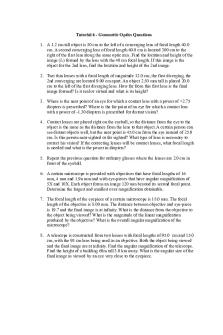PHY 134 Geometric Optics Lab Report PDF

| Title | PHY 134 Geometric Optics Lab Report |
|---|---|
| Author | Wiam Homir |
| Course | Classical Physics Laboratory Ii |
| Institution | Stony Brook University |
| Pages | 4 |
| File Size | 85.2 KB |
| File Type | |
| Total Downloads | 19 |
| Total Views | 160 |
Summary
PHY 134 Geometric Optics Lab Report for classical laboratory II...
Description
PHY 134: Geometric Optics Lab Report By Wiam Homir TA: Bent Nielsen
Introduction: In this lab, we investigated and learned the basic principles of ray optics, Snell’s Law, and the Law of Reflection. For the second part of the lab, we studied the application of these laws on lenses. During this lab, we will be using the equation from Snell’s Law n1sin(θ1)=n2sin(θ2), as well as 1/do+1/di=1/f. In part I, we used the triangular prism and plugged in the laser, and measured the distances X1, Y1, X2, and Y2. For part IB, we looked at the external reflection and used the triangular prism to point the laser and see where the reflected beam is. In part IC, we observed the total internal reflection and this was in order to see the exact same degrees on both angles. As for part 2, we observed the lenses and attempted to determine two focal lengths for two measurements.
Data: See Datasheet shared on google drive: https://docs.google.com/spreadsheets/d/1mfnyBp34DKiY3IHSSqFtu9mlgvK5sDc OJweACFj20cs/edit#gid=0
Data Analysis: As for our results, in part 1A, my A&C measurement of n(Glass), 1.456021989+/-0.09000000164 did agree with the expected value of n=1.5 within uncertainty. My D&E measurement of n(Glass), 1.59588611+/-0.2123688255 also agreed within uncertainty with the expected value of n=1.5. For part 1B, we observed that our incident angle of 45 degrees also received a reflected angle of 45 degrees. My measured angles did not obey the Law of Reflection. For the glass, the
intensity of the reflected beam was dimmer as it was going through the glass. For the mirror, the intensity of the reflected beam was brighter as it was more prominent and reflected brightly. My previous two results did align with my expectations. As for part 1C, my measurement of n(Glass), 0.8511528393 +/-0.001234496482 did not agree with the expected value of 1.5 within uncertainty. The intensity of the incident beam was the same as I approached the critical angle. The intensity of the refracted beam was dimmer as I approached the critical angle. The intensity of the reflected beam was brighter as I approached the critical angle. In part IIA, for measurement 1, my focal length was 5.769230769 +/-0.05166934245 cm and it did not agree within uncertainty with the value of 5cm neither did the value of the second measurement of the focal point of 7.142857143+/-0.05166934245 cm. For IIB, there was no location where the diverging lens made an image on the screen, nature if the image was virtual, the image I saw through the diverging lens is upright and demagnified. It does not depend on how close my eyes are to the lens.
Calculations: See the link to the datasheet, all calculations are included in data sheet
Discussion: Alternative Lens Configuration Choice: The further away the object is placed, the further away the image is and the magnification m=di/do becomes larger. If we used a 2cm converging lens instead of 5cm, the object distance would be smaller than the object distance for 5cm. If we were to place the arrow and lamp really far away, the image would be inverted after doing the calculations. We would do 1/f=1/di and m=0.
Radio Waves: As for this situation, according to Snell’s Law, the light rays are dense medium and become less dense medium. The Ground would be greater than ionosphere....
Similar Free PDFs

PHY 134 Lab 2 Oscilloscope
- 11 Pages

Geometric Optics Tutorial 6
- 1 Pages

Geometric Optics Summary Sheet
- 7 Pages

Lab Report Fiber Optics
- 5 Pages

Lab Ph ET Geometric Optics 2
- 3 Pages

Lab report optics
- 2 Pages

PHY lab 1 report
- 5 Pages

PHY 400 - LAB REPORT 1
- 2 Pages

PHY 221 Lab Report 7
- 6 Pages

Optics Lab - lab assignment
- 5 Pages

Ray-Optics-Lab - lab
- 11 Pages

PHY lab report 5 - Grade: A-
- 18 Pages

Hooke\'s Law Lab Report PHY 113
- 6 Pages
Popular Institutions
- Tinajero National High School - Annex
- Politeknik Caltex Riau
- Yokohama City University
- SGT University
- University of Al-Qadisiyah
- Divine Word College of Vigan
- Techniek College Rotterdam
- Universidade de Santiago
- Universiti Teknologi MARA Cawangan Johor Kampus Pasir Gudang
- Poltekkes Kemenkes Yogyakarta
- Baguio City National High School
- Colegio san marcos
- preparatoria uno
- Centro de Bachillerato Tecnológico Industrial y de Servicios No. 107
- Dalian Maritime University
- Quang Trung Secondary School
- Colegio Tecnológico en Informática
- Corporación Regional de Educación Superior
- Grupo CEDVA
- Dar Al Uloom University
- Centro de Estudios Preuniversitarios de la Universidad Nacional de Ingeniería
- 上智大学
- Aakash International School, Nuna Majara
- San Felipe Neri Catholic School
- Kang Chiao International School - New Taipei City
- Misamis Occidental National High School
- Institución Educativa Escuela Normal Juan Ladrilleros
- Kolehiyo ng Pantukan
- Batanes State College
- Instituto Continental
- Sekolah Menengah Kejuruan Kesehatan Kaltara (Tarakan)
- Colegio de La Inmaculada Concepcion - Cebu


